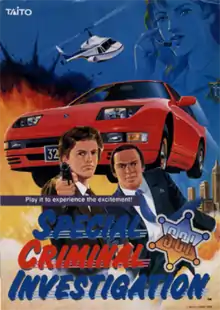Special Criminal Investigation
Special Criminal Investigation, also known simply as S.C.I. and Chase HQ II: Special Criminal Investigation in some versions of the home ports, is a 1989 arcade game published by Taito and is the sequel to the 1988 original Chase H.Q.
| Special Criminal Investigation | |
|---|---|
 North American Special Criminal Investigation arcade flyer. | |
| Developer(s) | Taito |
| Publisher(s) | Taito |
| Series | Chase |
| Platform(s) | Arcade, Amiga, Amstrad CPC, Atari ST, Commodore 64, MS-DOS, Sega Master System, PC Engine, ZX Spectrum |
| Release | 1989 |
| Genre(s) | Racing game, Action game |
| Mode(s) | Single-player |
| Arcade system | Taito Z System |
Gameplay

Instead of the black Porsche 928 of the first game, the player commands a red example of the just-introduced (at the time) Nissan 300ZX Z32 T-Top Turbo. Unlike the first game, the player is able to fire at offending vehicles, with some cabinets containing buttons on the steering wheel, and others having a fire button on the gearshift, along with a button to activate the nitrous boost.
The game brings back protagonists Tony Gibson and Det. Raymond Broady of the first game, and their second game appearance. Broady has taken over the driver's seat this time, while Gibson, as the passenger, serves as the gunman. Also, instead of Nancy, Karen is the officer delivering reports of whom the criminal is pursuing, and what they are driving.
Ports and related releases
Conversions for Amiga, Atari ST, PC, Commodore 64 and ZX Spectrum were released in 1991 by Ocean Software, developed by Glasgow's ICE Software. A conversion for the PC Engine (TurboGrafx-16) was released in January 1991 exclusively in Japan by Taito. Natsume ported it to the Sega Master System. An Amstrad CPC version was written but never released, and only a small number of cartridges are known to exist.
In 1996, Taito released an emulation of the arcade original for the Sega Saturn in Japan, bundled together with Chase H.Q. on one disc.[1]
Reception
| Publication | Score |
|---|---|
| CVG | (PC Engine) 85%[2] (Amiga) 84%[3] (C64) 79%[4] |
| Sinclair User | (Arcade) 8/10[5] |
| Your Sinclair | (Arcade) 94%[6] (Spectrum) 80%[7] |
| ACE | (Arcade) |
| Commodore User | (Arcade) 86%[9] (Amiga) 72%[10] |
| Zero | (Arcade) (Amiga) 81%[12] (Atari ST) 79%[13] |
| Raze | (PC Engine) 89%[14] |
| Zzap!64 | (C64) 93%[15] (Amiga) 91%[16] |
In Japan, Game Machine listed Special Criminal Investigation on their December 1, 1989 issue as being the second most-successful upright arcade unit of the year.[17]
References
- "Taito Chase H.Q. Plus S.C.I.: Traffic Cops Take it to the Bad Guys!". Sega Saturn Magazine. No. 12. Emap International Limited. October 1996. pp. 28–29.
- https://archive.org/stream/computer-video-games-magazine-113/CVG113_Apr_1991#page/n78/mode/1up
- http://amr.abime.net/review_27120
- http://amr.abime.net/review_27121
- http://www.solvalou.com/subpage/arcade_reviews/124/322/special_criminal_investigations_review.html
- http://www.solvalou.com/subpage/arcade_reviews/69/322/special_criminal_investigations_review.html
- Your Sinclair, issue 63
- http://www.solvalou.com/subpage/arcade_reviews/46/322/special_criminal_investigations_review.html
- http://www.solvalou.com/subpage/arcade_reviews/287/322/special_criminal_investigations_review.html
- http://amr.abime.net/review_8934
- https://archive.org/stream/zero-magazine-04/Zero_04_Feb_1990#page/n90/mode/1up
- http://amr.abime.net/review_40279
- http://amr.abime.net/review_40280
- https://archive.org/stream/RAZE_Issue_09_1991-07_Newsfield_Publishing_GB#page/n57/mode/1up
- http://amr.abime.net/review_5594
- http://amr.abime.net/review_5593
- "Game Machine's Best Hit Games 25 - アップライト, コックピット型TVゲーム機 (Upright/Cockpit Videos)". Game Machine (in Japanese). No. 369. Amusement Press, Inc. 1 December 1989. p. 29.